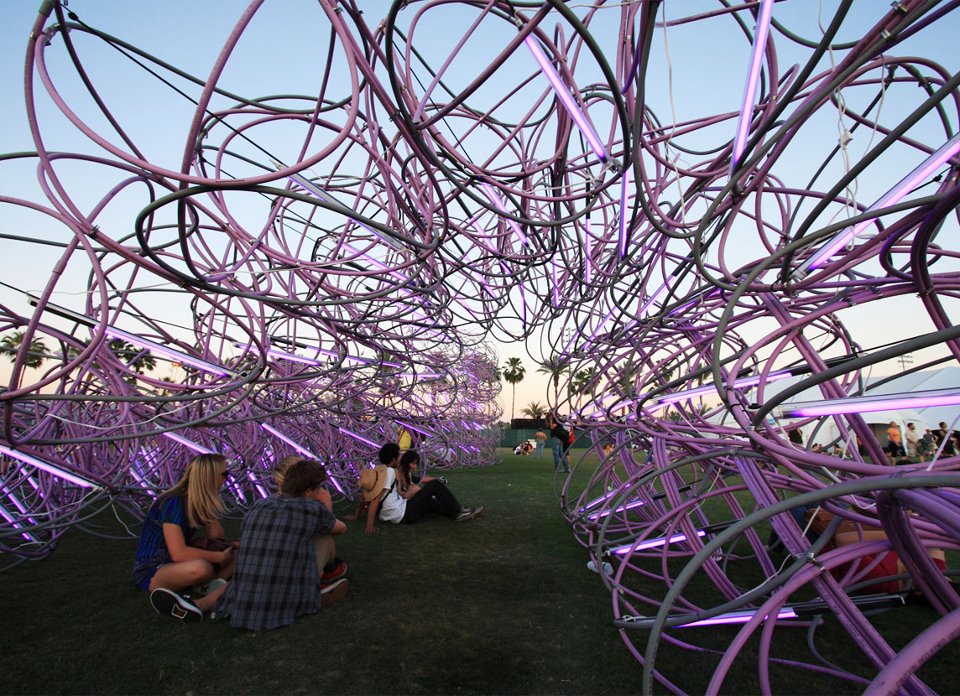

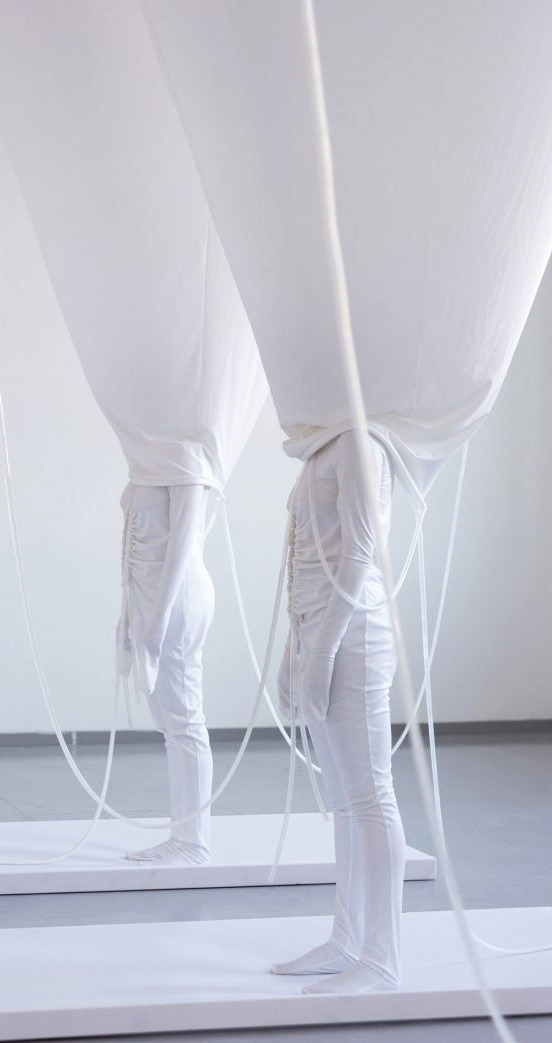
MALIN BÜLOW
Legame elastico
Le installazioni performative di Bülow attirano l’attenzione sul corpo e in particolare sulla pelle. Con accanto alla acutezza clinica cerca di toccare i punti deboli relazionali intorno alla nostra esistenza. Collabora con danzatori che diventano attivatori e detentori dei suoi interventi elastici, sensi-claustrofobici.

Hussein Chalayan
フセイン·チャラヤン
ЧАЛАЯН
후세인 샬 라얀
Gravity Fatigue
Fashion designer Hussein Chalayan has created elasticated costumes and sequinned garments for performers in his first self-directed dance production (+ slideshow).The production is split into 18 chapters that each explore themes of identity, displacement and invisibility.

MALIN BÜLOW
Elastic Bonding
Bülow’s performative installations draw attention to the body and in particular the skin. With next to clinical sharpness she seeks to touch upon the relational painspots around our existence. She works together with dancers that become activators and holders of her elastic, sensi-claustrophobic interventions.

Fabrice le Nezet
Elasticity
With an urge to constantly explore the intersection between architecture, fashion, and product design, london-based artist Fabrice le Nezet has created ‘Elasticity.’ the work materializes the idea of tension by making the notion of weight and stretch palpable through the use of four massive and abstract metal structures. These components run perpendicularly across the long edges of rectangular voids in the ceiling. by presenting this normal condition, several of the wires bend to support large prisms of concrete that provide a feeling of force and motion. as they drop down to occupy spaces below, movement is emphasized by their strategic orientation below clerestory windows shining light onto the forms. As observers move around the constructs, a contrast is created between the real properties of the materials and the way they are perceived.
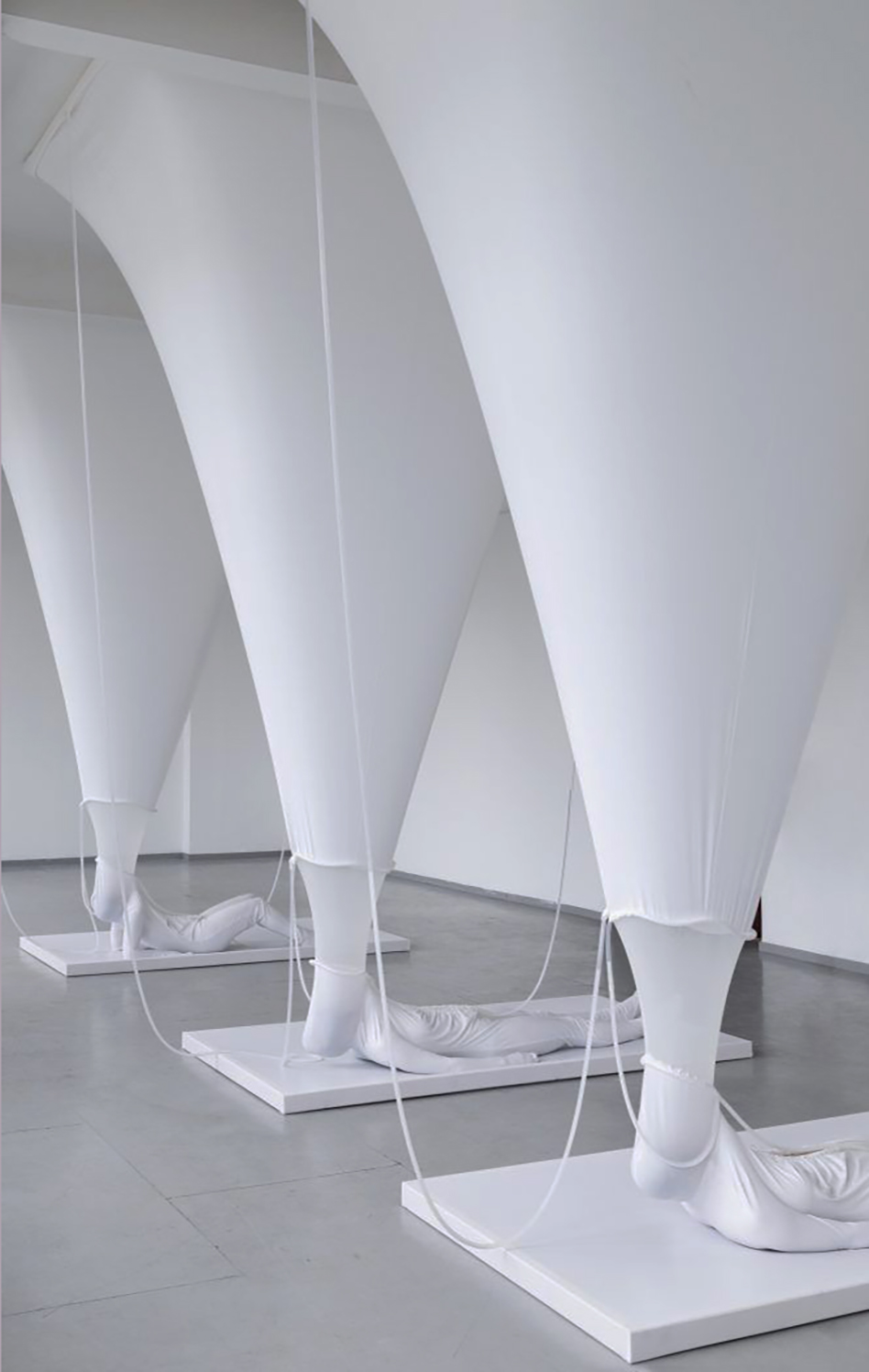
Malin Bülow
马林·比洛
マリンビューロー
말린 블로우
Μαλίν Μπάλοου
Elastic Bonding
This vertical version of Elastic Bonding was made site specifically for the Project Space at Lademoen Kunstnerverksteder in Trondheim. It was shown as part of Multiplié dance festival, an annual festival of contemporary dance in Norway. The project was a collaboration between Babel visningsrom and DansiT.

Cod.Act
πTon/2
πTon/2 is a sound installation that intervenes in the continuity of the researches of Cod.Act on mechanical and sound organicity. It results from an experience on the deformation of an elastic form and its incidence on the evolution of a musical work. The object is a flexible ring closed on itself. It is set in motion by torsional engines located inside its body. πTon, by twisting and waving on itself, moves in a very natural and unpredictable way.

JACQUES LESEC & CHRIS MARTIN
INDUSTRIAL CREEPER
On the site we envision a antagonistic dialogue between the seemingly biologic units and its abiotic architectural foundation. The units find a home intertwined amongst the predictable regularity of the steel configuration remeniscent of a deteriorating and outdated technological era whose remnants can be found scattered across downtown Los Angeles. These old industrial artifacts, derived from sheer function, act as an all too familiar platform by which the occupant interacts with this new synthetic ecological system. Throughout the site, we see the units stretched and twisted in an extraodinary demonstration of elasticity. In this way, the building lingers in a constant state of mediation between the past and the future; succombing to the complex configuration of the aggressive industrial creeper.
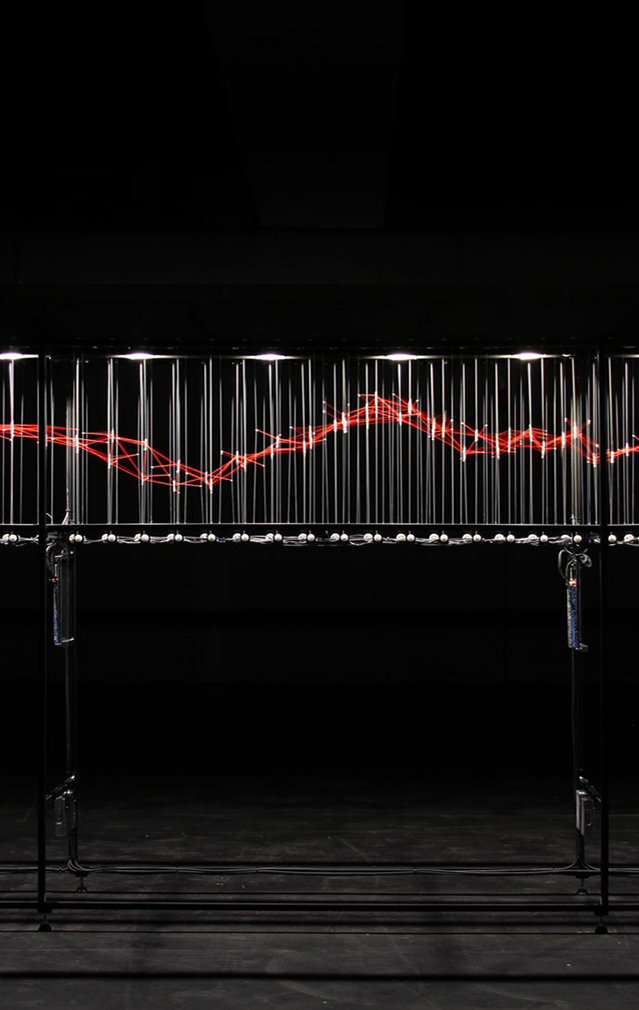
Ralf Baecker
INTERFACE I
Interface I investigates the boundary between two interacting systems rendered into the physical. Each system is a compound of motors, strings and elastic bands arranged horizontally. The two units face each other vertically (one on the top, one on the bottom). Each motor of one level (top, bottom) is connected to its opponent with a string, meeting in the center. Both motors pull their string in the opposite direction (like in a tug of war). At the junction of the strings, a mesh of elastic bands connects the string to its neighbours. The mesh couples each element to its surrounding elements in order to achieve a local emergent behaviour.

IAAC Team
Soft Skin
‘Soft Skin’ is a research project developed by Lubna Alayeli, Nina Jotanovic, Ceren Temel, and Farah Alayeli from the Institute for Advanced Architecture of Catalonia. The work investigates the possibilities of using air inflation in architecture as an active response to changing environmental parameters. The ‘skin’ is composed of a specially developed composite made of thin layers of flexible silicone and elastic fabric. The material system consists of dozens of inflatable cells combined in larger groups. As parameters change — light and wind in this instance — the cells can inflate or deflate in real time. By acting in real time, it is able to reduce wind vibrations and wind drag, and control light infiltration.
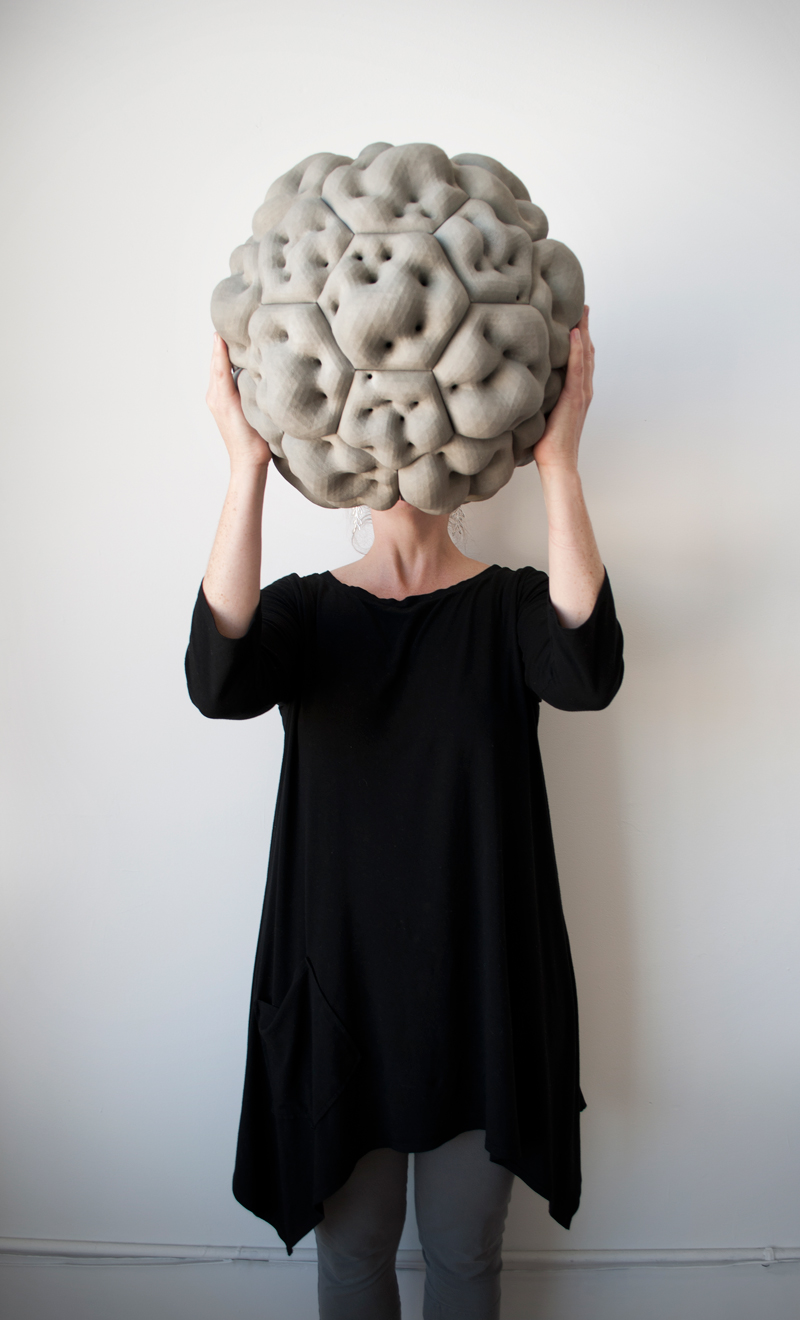
Andrew Kudless
p_ball
This project investigates the self-organization of two materials, plaster and elastic fabric, to produce evocative visual and acoustic effects. Inspired by the work of the Spanish architect Miguel Fisac and his experiments with flexible concrete formwork in the 1960-70s, p_wall attempts to continue this line of research and add to it the ability to generate larger and more differentiated patterns. Starting from an image, a cloud of points is generated based on the image’s grayscale values.

HANS HEMMERT
한스 해머
ハンス・ハマート
Hans Hemmert is fascinated by air and latex balloons in a bright canary yellow. But these aren’t just your average latex inflatables, some fill entire rooms while others surround Hemmert himself. Posing as a giant elongated egg, he performs dances or interacts with the objects outside his elastic bubble.

zaha hadid architects
Casa Atlântica
La oficina de arquitectura Zaha Hadid Architects reveló el diseño de su primer proyecto brasileño, un edificio residencial de lujo conocido como Casa Atlântica, que se localizará en la Avenida Atlântica en Copacabana, Río de Janeiro. El edificio que contará con 11 pisos, incluye una fachada cuya imagen parece ser una espina con amplios balcones y una piscina en la cubierta. De acuerdo con la oficina de arquitectura de la famosa arquitecta Zaha Hadid: “Las formas naturales de las colinas y playas de Río de Janeiro genera una cualidad elástica y maleable dentro del tejido urbano de la ciudad, al momento que el dinamismo de Copacabana –con su energía y ritmo– hace de éste un de los espacios públicos más importantes de la ciudad”

HANS HEMMERT
한스 해머
ハンス・ハマート
Hans Hemmert is fascinated by air and latex balloons in a bright canary yellow. But these aren’t just your average latex inflatables, some fill entire rooms while others surround Hemmert himself. Posing as a giant elongated egg, he performs dances or interacts with the objects outside his elastic bubble.

ERNESTO NETO
Эрнесто Нето
ارنستو نيتو
埃内斯托·内图
ארנסטו נטו
エルネスト·ネト
어네스토 네토
Humanóide
Ernesto Neto’s work reflects the participatory trend amongst Brazilian artists during the 1960s and 70s that is frequently associated with Lygia Clark and Hélio Oiticica. Neto’s morbid sculptures and installations consist of elastic nylon or Lycra that is stitched into various organic shapes, which unfold in a womblike fashion around the spectator. Neto comments that his sculptures suggest ‘fertility, sexuality, touching, and kissing’, as well as atmospheric associations that arise out of the particular spatial presence and detailed texture of the surfaces.

Vesa-Pekka Rannikko
Canary
Les grimpeurs ne prêtent pas leurs cordes. Ils doivent leur faire confiance, connaître leurs antécédents d’utilisation, leur usure, leur élasticité et leur durabilité. Les différentes couleurs de cordes représentent des usages spécifiques. Accroché à flanc de montagne, c’est un soulagement de savoir quoi ou qui est au bout de quelle corde. Canary est basé sur l’histoire de l’élevage des oiseaux, qui est une métaphore directe du mélange pictural des couleurs. L’obsession de créer l’oiseau rouge au début du XXe siècle est comme l’objectif d’une peinture monochromatique parfaite. Les notions d’amélioration raciale ont des liens avec la discussion contemporaine sur l’éthique de la génétique. J’ai également considéré le lien entre la pureté de la forme moderne et le point de vue idéaliste. Lorsqu’un tableau ou une œuvre de sculpture est réduit à sa surface, il est idéalisé pour n’être que ce que nous y voyons. Le motif visuel d’une œuvre ne sert que de composition.

Marshmallow Laser Feast
Laser Forest
O público pode explorar livremente o espaço, batendo fisicamente, agitando, arrancando e vibrando as árvores para acionar sons e lasers, provocando uma experiência coletiva bem interativa. Devido à elasticidade natural do material, a interação com as árvores fazia com que elas oscilassem, criando padrões de vibração de luz e som. Cada árvore estava sintonizada com um tom específico, criando sons harmoniosos espacializados e jogados através de um sistema de som surround poderoso, e quanto mais gente, mais legal ficava o experimento. A instalação foi projetada para trazer para fora em adultos os sentimentos de curiosidade e admiração, que são tão viva e evidentes nas crianças.




MARSHMALLOW LASER FEAST MEMO AKTEN ROBIN
McNicholas and Barney Steel
Laser Forest
The public can explore the space, physically hitting, shaking, pulling and vibrating like trees for trigger sounds and lasers, provoking a very interactive collective experience. Resulting from the natural elasticity of the material, an interaction with the trees created with which they oscillate, creating patterns of vibration of light and sound. Each tree was tuned to a specific tone, creating harmonious children spatialized and played through a powerful surround sound system, and the more people, the cooler the experiment. The facility was designed to bring out in adults the feelings of curiosity and awe that are so vivid and evidence in children.